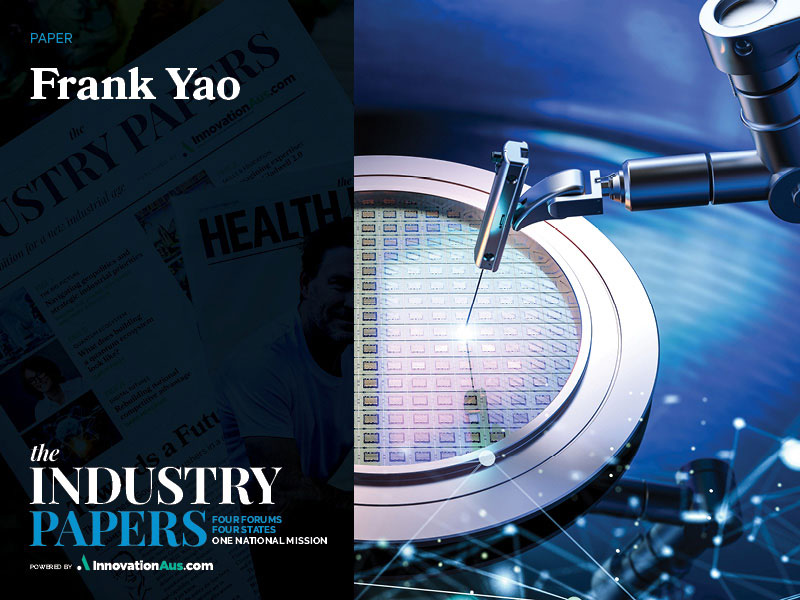Advancements in 3D laser nanoprinting technology present unprecedented opportunities for developing a robust nanomanufacturing ecosystem. In Australia, leveraging this cutting-edge technology can transform various sectors, including healthcare, photonics, electronics, energy, agriculture, and materials science, and propel the nation to the forefront of global nanotechnology innovation.
This paper briefs government, sector leaders, and the public on the potential of 3D laser nanoprinting, its current state, prospects, and the strategic steps required to establish a thriving nanomanufacturing ecosystem in Australia.

The promise of 3D laser nanoprinting
3D laser nanoprinting is an advanced form of additive and subtractive manufacturing that enables the creation of intricate nanostructures with exceptional precision, complexity, and throughput.
This technology uses focused laser beams to manipulate materials at the nanoscale, one-thousandth the size of a human hair, either by adding material (additive manufacturing) or removing material (subtractive manufacturing), to fabricate complex 3D nanostructures crucial for applications in photonic devices, biomedical implants, micro-electromechanical systems (MEMS), and nanostructured materials with unique properties.
The potential of 3D laser nanoprinting lies in its ability to produce structures with nanoscale precision, essential for developing next-generation devices and materials. According to Fact.MR, the global 3D printed nanocellulose market size is estimated at US$21.89 billion in 2024 and is forecast to reach US$85.23 billion by 2034, advancing at a CAGR of 14.6 per cent.
Australian-made breakthroughs in 3D laser nanoprinting
3D laser nanoprinting holds immense potential for revolutionising nanomanufacturing but has remained predominantly a laboratory technology due to several critical challenges. Achieving and maintaining nanometre-scale precision and accuracy requires sophisticated equipment, experience, and expertise, limiting its use to a small number of specialists and affordable only for well-funded luxury labs.
Throughput and scalability are inversely related to fabrication accuracy; as accuracy reaches nanometre (nm) limits, success rate, throughput, and scalability decrease significantly. These challenges, combined with the lack of standardised regulatory frameworks, have kept 3D laser nanoprinting as a hidden treasure in laboratories for over 25 years.
Innofocus, an Australian company specialising in photonics technology, has made significant advancements in 3D laser nanoprinting, contributing to establishing a nanomanufacturing ecosystem in Australia.
Its nanomanufacturing capabilities are based on significant original technological breakthroughs developed over the past six years, including:
- Systems capable of fabricating 3D nanostructures with a resolution better than 100 nm (1,000 times finer than conventional 3D printing technologies), enabling the production of intricate structures for photonics, electronics, and biomedical devices
- Parallel fabrication technology allowing simultaneous processing of multiple laser focal points, increasing manufacturing speed and efficiency, and making nanomanufacturing viable for mass production
- Integration of AI and machine learning algorithms to optimise the nanoprinting process. These include surface auto-landing and surface tracing AI-vision technologies, ensuring precise and efficient manufacturing
- In-situ characterisation and feedback. Innofocus nanoprinting systems include the only in-situ 3D refractive index characterisation modules. This technology enables real-time, high-resolution imaging of fabricated nanostructures, allowing immediate adjustments during the printing process
- Systems that are user-friendly and capable of turnkey operation, reducing the dependency on expert knowledge and making the technology more accessible
The technological breakthroughs made by Innofocus have significantly advanced 3D laser nanoprinting, improving precision, reliability, and scalability, making nanomanufacturing more accessible and closer to industry-scale applications.
Global landscape of 3D laser nanoprinting
Germany and Sweden have established leading expertise in 3D laser nanoprinting, setting benchmarks in precision and scalability. Despite their advancements, limitations such as restricted material species and compromised throughput remain.
The potential and market size for 3D laser nanoprinting are vast. Australia, through our pioneering work, could lead the next wave of nanomanufacturing by leveraging Australian-made 3D laser nanoprinting technology.
3D laser nanoprinting is a transformative technology. It holds the potential to revolutionise various sectors by enabling the creation of highly precise and complex nanostructures. Significant advancements can be achieved in areas such as biomedical, energy, agriculture, optoelectronics, sensing, communications, quantum technology, and integrated devices.
In the biomedical sector, 3D laser nanoprinting can revolutionise tissue engineering and drug delivery systems. It can fabricate scaffolds with precise nanostructures that mimic the extracellular matrix, promoting cell adhesion, growth, and differentiation. Nanoprinted devices can also be used for controlled drug delivery, targeting specific sites within the body to improve therapeutic efficacy. For example, researchers have used 3D laser nanoprinting to create biodegradable scaffolds that support bone tissue growth, enhancing outcomes in bone regeneration.
For the energy sector, enhancing solar cells and battery technology through nanostructured materials, 3D laser nanoprinting can improve the efficiency of photovoltaic cells by increasing light absorption and reducing energy losses. Nanoprinting can produce electrodes with high surface area and improved electrochemical properties, resulting in batteries with higher energy density and longer life cycles.
In agriculture, 3D laser nanoprinting facilitates precision agriculture and controlled pesticide delivery. Nanoprinted sensors can provide farmers with real-time data to monitor soil health, crop growth, and environmental conditions with high sensitivity and specificity. Nanoparticles designed for controlled pesticide delivery can reduce chemical use, minimising environmental impact and improving crop yields.
Through the creation of complex photonic structures, this technology can have impact on the optoelectronics field. It enables the fabrication of waveguides, photonic crystals, and microresonators, essential for modern optoelectronic devices.
3D laser nanoprinting also enables the creation of extremely sensitive biosensors and environmental sensors. Nanoprinted biosensors can detect biological molecules with high sensitivity, enabling early diagnosis of diseases and the monitoring of patients, while environmental sensors can monitor pollutants and toxins in air and water with high precision.
Enhancements in optical communication components and antenna technology mean that nanoprinting can create optical fibres, modulators, and switches with improved performance, supporting high-speed data transmission relevant to the communications sector.
In the field of quantum technology, 3D laser nanoprinting is pivotal for producing qubits and other quantum devices with high precision. This technology can also create quantum sensors that exploit quantum mechanical effects to achieve unparalleled sensitivity and accuracy.
In the case of integrated devices, 3D laser nanoprinting enables the fabrication of microelectromechanical systems (MEMS) and nanoscale components for integrated circuits.
MEMS devices, such as accelerometers and pressure sensors, benefit from the high precision and complex nanostructures achievable with nanoprinting, leading to improved sensitivity and functionality. The creation of nanoscale components enhances the performance and miniaturisation of electronic devices, contributing to the advancement of modern electronics.
Benefits of nanodevices
Nanodevices produced through 3D laser nanoprinting offer significant benefits in performance and energy consumption. Precise control over material properties and structural features at the nanoscale enables the creation of devices with superior performance characteristics.
Nanostructured materials can exhibit enhanced electrical conductivity, thermal stability, and mechanical strength, essential for high-performance applications. The ability to fabricate energy-efficient components such as low-power sensors, high-capacity batteries, and efficient photovoltaic cells can lead to significant reductions in energy consumption, contributing to sustainability and enhancing overall efficiency and functionality.
The innovations from Innofocus have contributed to making these advancements practical and scalable, positioning nanomanufacturing for widespread industrial adoption and significant societal benefits.
A thriving local ecosystem
To harness the full potential of 3D laser nanoprinting and establish a robust nanomanufacturing ecosystem, a comprehensive strategic approach is necessary. This involves fostering collaboration, supporting innovation, ensuring a skilled workforce, and making the technology accessible to a wide range of users.
Strengthening collaborations between universities, research institutions, and private companies is crucial for the development and commercialisation of 3D laser nanoprinting technologies.
These partnerships facilitate the transfer of knowledge and resources, accelerating innovation and applications. Innofocus has established the Nanomanufacturing Practice Centre (NMP) and a new plant, which serve as hubs for innovation, providing state-of-the-art facilities and resources for researchers and industry professionals.
Robust financial support and favourable policies from the government can significantly reduce the economic barriers faced by SMEs in adopting nanoprinting technologies. Government initiatives, such as grants, tax incentives, and subsidies, can spur innovation and enable wider adoption. Establishing innovation hubs and incubators can provide startups and SMEs with the necessary infrastructure and support to develop and commercialise their nanoprinting solutions.
Building a skilled workforce is essential for the successful implementation and advancement of 3D laser nanoprinting systems. Educational institutions must establish specialised training programs in nanotechnology and precision engineering. Integrating these programs into university curriculums will equip students with the skills and knowledge required to operate and innovate in the field of nanoprinting.
Ongoing professional development and training for industry professionals can help them stay updated with the latest technological advancements and best practices.
Developing standardised protocols and regulatory frameworks is critical to ensure the safety, reliability, and quality of nanomanufactured products.
Standardisation can facilitate the smoother integration of nanoprinting technologies into existing manufacturing processes and boost consumer confidence. Regulatory frameworks should address issues related to product safety, environmental impact, and ethical considerations – to ensure the responsible, sustainable use of nanoprinting technologies.
Highlighting successful applications and case studies of 3D laser nanoprinting can demonstrate its potential and encourage broader adoption across industries. Showcasing achievements can inspire other sectors to explore the technology’s capabilities and invest in its development. Success stories can be shared through industry conferences, publications, and media outlets to reach a wide audience.
Investing in ongoing R&D ensures that the technology remains at the cutting edge, addressing emerging challenges and seizing new opportunities. This includes developing related technologies in other sectors, such as advanced materials, AI integration, and improved manufacturing processes. By staying ahead in innovation, the nanomanufacturing ecosystem can continuously evolve and expand its applications.
Creating platforms that provide shared resources, technical support, and collaborative spaces where different industries can experiment with and implement nanoprinting technologies. These platforms can help integrate nanoprinting into diverse fields, from biomedical to quantum technology, enhancing overall industry capabilities.
Australian-made 3D laser nanoprinting technology offers novel solutions to longstanding challenges across various sectors. By harnessing its full potential, Australia can create technology-enabled economic growth and sustainable social and environmental benefits.
This revolutionary approach has the capacity to transform diverse industries, from biomedical to optoelectronics, enhancing performance, reducing energy consumption, and fostering innovation. Through strategic initiatives and continued support, Australia can lead the next wave of nanomanufacturing, setting new standards for technological advancement and sustainable development.
Frank Yao, CEO and founder, Innofocus. Frank is an entrepreneur focused on transforming technologies into business solutions and value services. Frank has over 20 years’ experience in the technology, manufacturing, and professional service industries, with experience of business development in Europe, Asia, America, and Australia. Frank is an Australian Innovation Competition winner (2023), recipient of the Australian Made award 2022 and 2023, and the Engineers Australia 2022 Excellence Award. His experience includes strategy planning, portfolio management, marketing and sales, branding, solution development, and program management.
This article is part of The Industry Papers publication by InnovationAus.com. Order your hard copy here. 36 Papers, 48 Authors, 65,000 words, 72 page tabloid newspaper + 32 page insert magazine.
The Industry Papers is a big undertaking and would not be possible without the assistance of our valued sponsors. InnovationAus.com would like to thank Geoscape Australia, The University of Sydney Faculty of Science, the Semiconductor Sector Service Bureau (S3B), AirTrunk, InnoFocus, ANDHealth, QIMR Berghofer, Advance Queensland and the Queensland Government.
Do you know more? Contact James Riley via Email.

